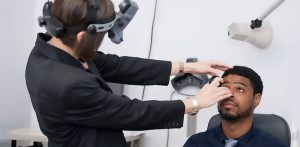Multiple Sclerosis impacts the lives of over 140 in 100,000 people.
Multiple sclerosis (MS) is a disease where the immune system attacks the healthy nerve cells in the body, causing damage to their protective coatings (myelin sheath). This autoimmune response results in long-term damage and scarring in the brain— and leads to a range of uncomfortable symptoms.
The National Multiple Sclerosis Society (NMSS) warns that vision problems are often the first sign of the disease.
Common vision problems associated with MS
There are a wide range of vision problems that can affect people with MS, and no two people are alike. These vision problems can affect one or both eyes, and either cause permanent damage or worsen before suddenly disappearing.
Being aware of the different types of visual disturbances associated with MS will not only facilitate better understanding, but will also ensure the most appropriate management.
1. Optic neuritis
Optic neuritis may be the first sign of MS.
According to the Multiple Sclerosis Trust, 70% of MS patients will develop optic neuritis at some point in their lives.
The optic nerve connects the eyes to the brain. Optic neuritis occurs when the myelin sheath that surrounds the optic nerve becomes damaged— as MS progresses, this demyelination can become more extensive.
Symptoms of optic neuritis include blurry or cloudy vision in your central and/or peripheral field of vision, colors appearing less vibrant, and mild to moderate pain- especially upon eye movement.
2. Diplopia (double vision)
Double vision can occur when MS affects the brain stem.
In healthy visual functioning, each eye sends identical information to the brain, where it is interpreted and processed into a single, clear and 3-dimensional image that you can understand.
When MS affects the nerves in the brainstem that enable eye muscle movement, uncoordinated eye movements result. Consequently, each eye sends different images to the brain which cannot be fused together to create a single image— leading to double vision.
Although advancing MS can cause permanent diplopia, in some cases, the diplopia will resolve completely and spontaneously.
3. Nystagmus
Nystagmus occurs when MS affects the inner ear or the cerebellum, the brain’s coordination center.
Nystagmus is a vision condition where the eyes make repetitive and uncontrolled rhythmic movements that feel like an eye jerking or jumping sensation. This often leads to dizziness and nausea and can occur when glancing in a particular direction, or while participating in certain activities.
MS frequently causes oscillopsia, the sensation that the world is swaying from side to side or up and down.
4. Vision loss
Vision loss occurs when advanced MS causes progressive optic nerve damage.
The symptoms of MS tend to worsen as the disease progresses, and can cause long-term visual effects and even permanent vision loss.
If you or a loved one has been diagnosed with MS, schedule an eye exam with an eye doctor near you to protect your eye health and vision.
SEE RELATED: Neuro-Optometry
How are these vision problems treated?
Each type of visual disturbance resulting from MS has its own set of treatment options.
Your eye doctor will determine the most effective treatment plan for you, based on the severity of your symptoms and general physical health.
The following are some of the most commonly prescribed treatments:
- Plasma exchange
Plasma exchange, commonly known as plasmapheresis, is a procedure to help control sudden and severe MS attacks known as relapses or flare-ups. These attacks are thought to be caused by certain proteins in the blood’s plasma.
Plasma exchange “cleanses the blood” by replacing the plasma in your blood with a donor’s plasma.
2. Eye patch
Covering one eye with an eye patch can provide relief from dizziness and nausea caused by double vision. The eye patch suppresses the vision from one eye, therefore eliminating double vision altogether.
3. Systemic steroids
Although steroids are generally not a long-term solution, they can help improve symptoms caused by certain visual disturbances, and may also help to prevent the recurrence of a visual disturbance.
Oral steroids are typically prescribed for the duration of 1 to 5 days, while intravenous steroids are generally given over a 3-day period.
It is important to be aware that steroid medications can cause side effects, such as stomach irritation, mood swings, elevated heart rate and insomnia.
4. Other medications
A medication called Clonazepam (Klonopin) can help relieve the jumping or swaying sensation caused by nystagmus, and an over-the-counter antihistamine can help alleviate visual symptoms caused by optic nerve damage.
According to a 2017 study published in the Lancet, it was found that over-the-counter antihistamines increased the speed of the neural signals from the eye to the back of the brain. While more research is needed, these medications may provide hope to people who have already suffered optic nerve damage.
LEARN MORE: Guide to Neuro-Optometry
If you or a loved one has been diagnosed with MS, schedule an eye exam with an eye doctor near you to ensure your eyes stay healthy.
If you have MS and notice any changes in your vision, consult with an eye doctor immediately.
Early diagnosis and treatment is crucial for optimal results.









